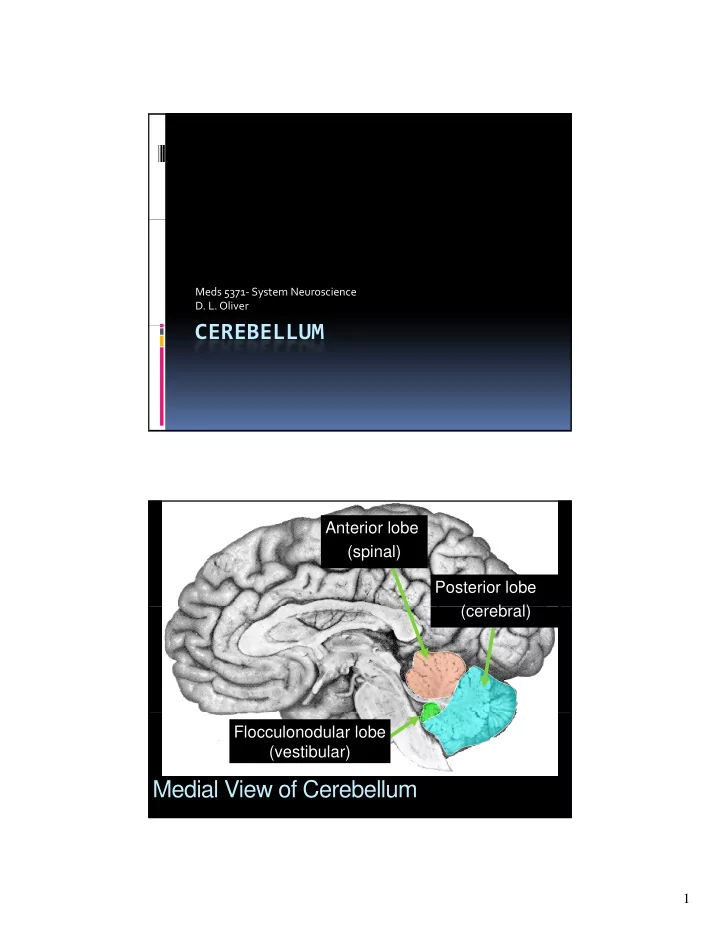

Meds 5371 ‐ System Neuroscience D. L. Oliver CEREBELLUM CEREBELLUM Anterior lobe (spinal) Posterior lobe ( (cerebral) b l) Flocculonodular lobe (vestibular) Medial View of Cerebellum 1
Ventral View of Cerebellum Flocculus Vermis Figure 19.1 Overall organization and subdivisions of the cerebellum (Part 4) 2
Cerebellar Peduncles Superior Middle Inferior Gross Anatomy of Cerebellum Cerebellar cortex • Lateral cortex Paravermis Vermis, spinal Paravermis Deep nuclei Folia, like Fastigial branches Interposed of a tree Dentate Nuc 3
Basic Cerebellar Circuit CEREBELLAR CORTEX modulates (inhibits) the activity of the DEEP NUCLEI NUCLEI Vestibulo-Cerebellum Inputs / Outputs with vestibular system Spino-Cerebellum Inputs / Outputs with reticular formation - reticulospinal tract Cerebro-Cerebellum Inputs /Outputs with cerebral cortex via pontine nuc and thalamus Figure 19.3 Functional organization of the inputs to the cerebellum (Part 1) 4
Figure 19.3 Functional organization of the inputs to the cerebellum (Part 2) INPUT – Vestibular ganglia AND vestibular VESTIBULO- CEREBELLUM nuclei 5
Dorsal spinocerebellar Tract G C CST Dorsal spinocerebellar tract travels in lateral column to the cerebellum. Carries information about muscle stretch and contraction. Figure 19.5 Somatotopic maps of the body surface in the cerebellum 6
INPUT: P Pontine ti Nucleus Cerebro-cerebellum Figure 19.6 Functional organization of cerebellar ouputs Summary of Cerebellar Outputs 7
Figure 19.8 Functional organization of the major descending outputs from the cerebellum (Part 1) Descending Projections of Cerebellum Figure 19.8 Functional organization of the major descending outputs from the cerebellum (Part 2) 8
Output: Fastigial nucleus projects output to vestibular nucleus Output: Flocculus, , nodulus, and Fastigio-bulbar tract vermis project directly to vestibular nucleus VESTIBULO- CEREBELLUM Spinocerebellum Fastigial Nucleus Descending Fastigio-bulbar tract OUTPUT- to Reticular Formation. Influence the reticulospinal tract. 9
Figure 19.7 Functional organization of the major ascending outputs from the cerebellum (Part 1) Ascending Projections of Cerebellum Figure 19.7 Functional organization of the major ascending outputs from the cerebellum (Part 2) 10
OUTPUT: Interposed Spinocerebellum Nuclei Ascending Superior Cerebellar Peduncle (Brachium Conjunctivum) Spinocerebellum Ascending 11
Spinocerebellum Ascending OUTPUT: Termination in Red Nucleus; Influence the Rubrospinal tract. OUTPUT: Dentate Nucleus Cerebro-cerebellum 12
Cerebro-cerebellum VL Target: The VA-VL nuclei of the dorsal thalamus that project to motor cortex. Influences corticospinal tract. Other parts of dentate nucleus go to other thalamic nuclei and influence other parts of frontal lobe. Cerebellar Cortex in Rat 13
Cerebellar Cortex Neuron types in cerebellum In situ hybridization for VGAT, GABA transporter Top: A ‐ Purkinje B ‐ Basket or stellate C ‐ Golgi VGAT • In situ hybridization for VGLUT1, glutamate transporter • Bottom: – A ‐ Granule VGLUT1 – B ‐ White matter 14
Figure 19.9 A cerebellar Purkinje neuron in a living slice from mouse cerebellum Climbing Fiber input to Purkinje Cell (+) GLU Purkinje Cell (PC) 1. Origin – Inferior olive 2. Course – Restiform body (inferior cerebellar peduncle) (inferior cerebellar peduncle) 3. Laterality – Crossed Climbing fibers (CF) 4. Topographical Organization - Yes 5. Destination – Purkinje cell of Cerebellar cortex 15
(+) Parallel Parallel Fiber (PF) GLU Fiber Input to Purkinje Cell Granule Cell (+) (+) (GrC) GLU Purkinje Cell (PC) Mossy Fiber (MF) Golgi Cell GABA (-) Feed-back Basket Cell GABA (-) Feed-forward GABA Interneurons 16
Basic Circuit of Cerebellum Inputs to cerebellar cortex are climbing and mossy fibers fib Purkinje cells from cerebellar cortex inhibit the neurons of deep nuclei. Deep Nuclei project to targets targets (outside the cerebellum) that control one of four major motor tracts. 17
Groups of Parallel Fibers Link Groups of Purkinje Cells Only MF & PF Active During Previously Learned Movement Parallel Fiber (PF) (+) (+) (+) (+) (+) (+) (+) (+) (+) (+) (+) (-) (+) (+) (+) (+) (+) (+) (+) (+) (+) (+) Mossy Fiber (MF) 18
Both CF and MF/PF Systems are Active During a New Movement LTD at Parallel fiber fire (PF) Coincident firing Purkinje (+) (+) (+) (+) (+) (+) (+) (+) (+) (+) of parallel fibers (+) Cell and climbing fibers causes (+) (+) LTD at parallel fiber synapse (+) Climbing fiber fires (CF) (+) (+) (-) (-) (+) (+) (+) (+) (+) (+) (+) (+) (+) (+) (+) (+) Mossy Fiber (MF) More excitation on targets (+) from deep cerebellar nuclei 19
Recommend
More recommend